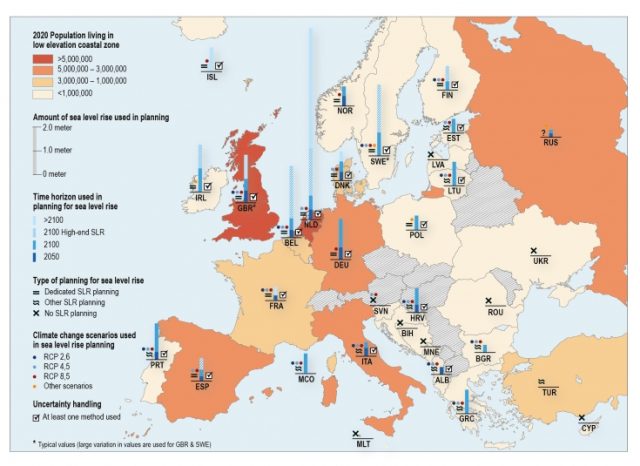Three quarters of European countries are planning for sea level rise
Sea level rise is expected to have severe consequences for people and assets in European coastal areas. Planning for sea level rise is critical in order to ensure timely and adequate responses. Deltares, Wageningen University and Utrecht University conducted a survey of experts from the 32 European countries with a coastline about how their country is planning for sea level rise. The conclusion is that most coastal countries in Europe are planning for SLR but that a quarter are still not doing so.

Significant differences
Most countries have adopted 2100 as the planning horizon and many countries are working with a sea level rise of approximately 1m (adjusted for local conditions) at that point in time. However, there are significant differences between countries and they could result in uneven impacts over time. We also found that RCP4.5 and RCP8.5 are the most widely used climate change scenarios in sea level rise planning, suggesting that countries are considering high-end climate change. However, this does not mean they are considering high sea level rise (for example as a result of rapid mass loss from Antarctica). Only a small number of countries in Europe are including such high-end sea level rise in their planning. Important questions remain about how planning is leading to different levels of protection or preparedness and whether the different projections for sea level rise and planning horizons that are being used at present will lead countries to act in time.

Sadie McEvoy (climate adaptation expert at Deltares): “Monitoring adaptation planning and levels of preparedness is important so we can identify gaps and act in time. I am very happy that we were able to conduct this study and produce the first overview of how countries in Europe are preparing for sea level rise”.
Adaptation strategies
Without adaptation, the level of annual damage in Europe projected at the moment could increase two or three times over by the end of the century. There are adaptation solutions available, ranging from protection, accommodation, coastal advance and strategic retreat. These adaptation strategies include engineering, ecosystem-based and sediment-based options. To manage uncertainties about sea level rise in the future, there is a preference for low-regret and flexible decisions that keep options open and that can be adapted over time. Adaptive-pathway approaches can contribute to these decision-making processes. Adaptation takes time to plan and implement, and decisions are currently being made that will have implications well into the future (socio-economic developments for example) and it is therefore crucial to adapt in good time and avoid investments that will be regretted later.
Marjolijn Haasnoot (climate adaptation expert at Deltares): “Even though three quarters of European countries are preparing for sea level rise at the national level, we found major differences. Some countries are preparing for a sea level rise of up to 20 cm in 2100. Others are following adaptive approaches to cope with a rise of 2 m by the end of the 21st century”.
——————-
Full title: How are European countries planning for sea level rise?
Authors: Sadie McEvoy (Deltares), Marjolijn Haasnoot (Deltares, Utrecht University), Robbert Biesbroek (Wageningen University)
Journal: Ocean and Coastal Management
Link to article: https://doi.org/10.1016/j.ocecoaman.2020.105512


